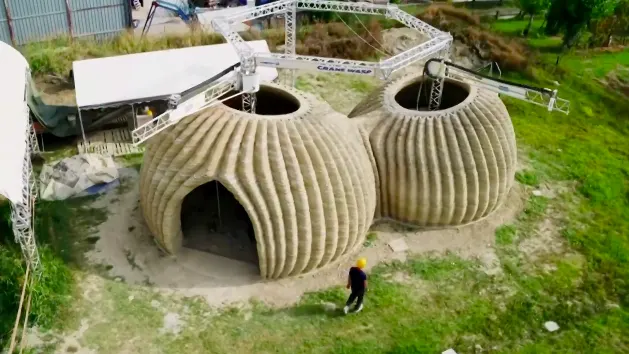
Italian company uses 3D printers and soil to build eco-houses
REUTERS - An Italian 3D printing manufacturer has completed the printing phase of its first eco-friendly 3D printed house, made entirely of sustainable, recyclable materials.
Local soil was the source material used by the 3D printers to build the circular, dome-shaped eco-habitats known as TECLA (technology and clay) in Ravenna, a city in northern Italy.
Two printers worked simultaneously for some 200 hours to build the structure, which manufacturer WASP predict could be the future of housing thanks to being carbon neutral and able to adapt to any climate or context.
It was the first time the company used a multi-printer system, known as Crane WASP, which they said "optimised the construction process and minimised human and energy resources."
The dual-domed structure could be a solution to the current housing crisis, according to WASP building engineer Alberto Chiusoli.

Credit: Reuters
“In some ways, planet earth is asking us for this approach, this challenge. So eco houses turn the traditional model into a new one that can be carbon neutral and zero emission,“ Chiusoli said during a Zoom interview.
To keep construction as green as possible, local soil was excavated from the ground at the site of the build, and was first dried and filtered to become more homogenous.
Once the soil was fine enough, it was mixed with rice waste and stabilisers to make it strong enough for construction, as well as water resistant. The end product is a clay.
Next, the building design is fed into the 3D printers, and 200 hours of printing later: voila!
"The 3D printers follow the digital instruction and produce one solution: the dome shape structure. So, from the ground to construction in just one unique process,” Chiusoli said.
In terms of manpower, only two people are needed for each printer, one for technical support and one to monitor the process of the materials.
Chiusoli said the printers are so advanced that they avoid any mistakes which could be made by human error.
“According to the U.N. sustainable development goals the traditional approach must be turned into a new sustainable one, more sustainable, more green."
"We do believe that 3D printing is the answer, it is the good and viable and resource-saving approach to do this.”
The final installation and presentation of the TECLA eco-homes is scheduled for spring.
(Production: Gabriele Pileri, Emily Roe)










